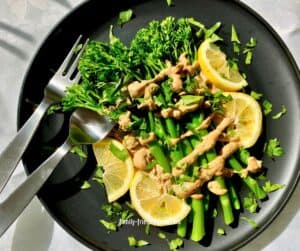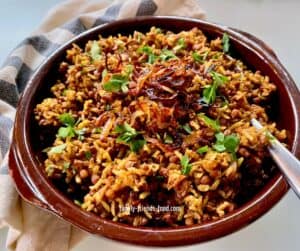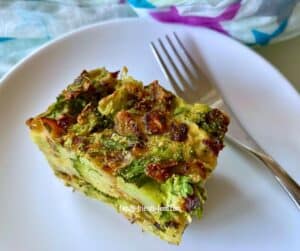Caponata alla Giudia is a delicious dish of aubergines (eggplant) in a sweet-and-sour tomato sauce, with olives and capers. Widely made, it has a surprising Jewish history.
I have made and eaten caponata many times. It’s a delicious vegetarian/vegan dish, made across Italy and around the world. It seems, however, that the Jewish origins of this delicious recipe are less well known. Did you know that caponata was created as a way for clever Jewish cooks to get ahead with their Shabbat preparations?
What is Caponata?
Caponata is an Italian dish of cooked aubergines (eggplant) in a sweet and sour tomato based sauce. It typically includes olives and capers, and may also feature pine nuts, raisins or currants, and other vegetables such as peppers or courgettes (zucchini).

Although it originated in Sicily, variations now exist across Italy. In the rest of the world it is usually simply called ‘caponata’. However the Italian name Caponata alla Giudia – ‘Jewish style caponata’ – gives away the dish’s original background.
Shabbat salad
According to The Encyclopaedia of Jewish Food by Gil Marks, the Jews of Sicily prepared a range of cooked vegetable dishes for Shabbat. They would serve these ‘salads’ cold as part of Shabbat lunch.

In the days before refrigeration, cooks used vinegar as a preservative. This enabled the preparation of food a day or two in advance of Shabbat. In order to counter the sharpness of the vinegar, a little sugar was also added. Thus, these dishes developed their characteristic sweet-and-sour or agrodolce flavour.
Caponata also uses many other classic Sicilian ingredients – olives, capers, pine nuts and sometimes raisins or currants.
Aubergines – melanzane – eggplant
Aubergines (eggplant) are the key ingredient in classic caponata alla giudia. Arab traders brought them from Asia, and introduced them into Sicily in around the 10th Century. Although Arabs and Jews ate aubergines enthusiastically, the rest of the population largely ignored them until a few centuries later.

Today, the aubergine is ubiquitous in Sicilian cuisine and beyond. It is enjoyed across Europe and around the world thanks to its extreme versatility and its ability to absorb flavours. Classic aubergine dishes include pasta alla Norma, melanzane parmigiana, moussaka, ratatouille, and numerous dips, spreads and sauces.
Caponata alla Giudia
I based my caponata recipe on the one that appears in la Cucina nella tradizione ebraica by Giuliana Ascoli Vitali-Norsa. In the book, the dish is called Caponata di Melanzane alla Giudia. As with many of the recipes in this wonderful and extensive collection, the ingredients are a little vague. It calls for celery, carrot and onion, but gives no idea as to quantity.

However, as these vegetables form the base of a tomato sauce, and the recipe does give an amount of tomatoes, I did my best to guess. The end result was delicious, so I don’t think I got it too far wrong!

Fry or grill?
To make a traditional caponata, you need to fry the aubergine pieces in a generous quantity of oil. However, because aubergine tends to absorb oil readily, I find this gives the finished dish a greasy quality that I don’t particularly like.
Instead of frying, I toss the aubergine cubes in a small amount of oil, then cook them under a hot grill (broiler). This produces crisp, golden cubes of aubergine, but without the oiliness. It’s also much quicker than frying in batches, since you can cook all of the aubergine in one go.

If you prefer a more traditional approach, you’re welcome to fry the aubergine instead of grilling. Dust the cubes in a little flour, then fry them in plenty of hot oil. Make the sauce as per the recipe below, then add the fried aubergines, garnish and serve!
How to garnish caponata
The book suggests chopped hard boiled egg as a garnish. However to keep the recipe vegan I have used pine nuts instead. They are still traditional in caponata, and add a lovely nutty flavour and a little crunch. You’re welcome to use chopped egg instead on your own caponata!

I also sprinkled on a little chopped parsley, although this isn’t traditional at all!
Main dish or side dish?
Caponata alla giudia was originally created to be part of a cold spread for Shabbat lunch. As such it makes a great side dish alongside other salads and cold items. It also makes a great first course ahead of a hot stew or cholent.
Serve your caponata as part of a Shabbat buffet with colourful Israeli chopped salad, crunchy red cabbage salad, classic French carrot salad, and filling tabbouleh salad with freekeh. You can see plenty more salads here.

You can also easily turn Caponata into a vegan main dish. Simply serve it warm or hot, with pasta, rice, couscous or polenta. We enjoy it this way, as a whole meal. You can also scoop it onto toasted bread for a quick lunch or a tasty starter.
Jewish history
I hope you have enjoyed learning about the Jewish history of this delicious Italian dish. Now, it’s time to enjoy eating it!

If you want deliciously easy, family-friendly recipes like this one delivered straight to your inbox, simply click here to subscribe. (Of course, I’ll never pass on your email address to anyone.)
📖 Recipe

Caponata alla Giudia
Ingredients
- 2 medium aubergines (eggplant)
- 3-4 tablespoon olive oil
- 1 stick celery
- 1 medium carrot
- 1 medium onion
- 1 clove garlic
- 300 g ripe tomatoes (approx. 5 tomatoes)
- 1 teaspoon dried basil
- 30 g pitted green olives (approx. 6 olives)
- 15 g capers, drained (approx. 3 tsp)
- 1 teaspoon red wine vinegar
- 1 teaspoon sugar
- salt and pepper to taste
- 2 tablespoon toasted pine nuts (optional)
Instructions
- Preheat the grill (broiler) to medium-high. Cut the aubergines into 1-1½ cm (½-¾ inch) cubes and place them in a bowl. Toss with 2 tablespoon of the olive oil and then spread them out on a rimmed baking sheet in as close to a single layer as possible.
- Cook the aubergine pieces under the grill (broiler) for five minutes, stir and spread out again. Grill (broil) for a further five minutes. Stir once more and grill (broil) for a final five minutes. The aubergine cubes should be cooked and browned. Set aside.
- While the aubergines are grilling (broiling) prepare the rest of the ingredients. Finely dice the celery. Peel and finely chop the carrot and onion. Peel and crush the garlic.
- Place the tomatoes in a large jug or bowl and cover with boiling water. After 2-3 minutes, fish them out and the skins should easily peel off. Roughly chop the flesh and set aside. Cut the olive in half lengthways.
- Heat the remaining oil in a large skillet over a medium-high heat. Add the chopped celery, carrot and onion, and the crushed garlic, and cook, stirring, for about 10 minutes until softened and starting to brown.
- Add the chopped tomatoes, basil, olives, capers, vinegar and sugar and mix well. Reduce the heat and cook for about 7-10 minutes to give a thick sauce.
- Add the grilled aubergine pieces to the sauce and gently mix everything together.
- Transfer to a bowl and garnish with the toasted pine nuts. Serve hot, warm or cold.
Notes
Nutrition
More aubergine recipes
If you’d like more delicious aubergine recipes, why not try these wonderful bulgar stuffed aubergines, this yummy aubergine shakshuka and this fabulous ricotta and aubergine lasagne.
More Italian recipes
If this caponata has whetted your appetite for Italian food, you might enjoy this delicious olive focaccia, this Sicilian style kale, or this fabulous peperonata.

I’m linking up this caponata recipe with #CookBlogShare.






Veenas
Just a Few Lines to Say Thank You So Much for the Wonderful Recipe !!! I’ll Definitely Try It.
Helen
Thanks Veena – glad you enjoyed it 🙂
Patti
Just finished eating this dish. Wonderful! It will become a staple in our meal planning! Served it with rice cooked in carrot juice.
Helen
Thanks for letting me know – I’mm so glad you enjoyed it! That rice sounds yummy 🙂
Mayuri Patel
Caponata Alla Giudia looks so tempting. What a wonderful way to enjoy eggplants and with that generous topping of pine nuts, simply irresistible.
Helen
Thanks Mayuri. The crunchy pine nuts really add a delicious flavour and texture. As you say, irresistible!
Marie-Charlotte Chatelain
This sounds fantastic! Love that it is low carb too! PErfect with chicken or some grilled shrimp
Helen
Thanks Marie-Charlotte. Yes, it’s low carb and goes with all sorts of things 🙂
Jess
This is such a great way to cook with eggplant!
Helen
Thanks Jess! I’m glad you enjoyed it!
Mirlene
There are so many delicious ways to make eggplants, and this is definitely one of them. Delicious and easy – what else to wish for?
Helen
Thanks Mirlene! I agree – delicious and easy is what to look for in a recipe!
David
I see this dish reference a lot but didn’t know about the Jewish origins, interesting! I like your approach for cutting down on the greasy aspect that eggplant can have sometimes.
Helen
Thanks David. I only learned of the Jewish background recently myself and found it so interesting I had to share!
Jen
I love the addition of both olives and capers. It adds so much complexity to the dish without much effort. A very delicious recipe!
Helen
Thanks Jen. We love olives and capers for a quick flavour win. Glad you enjoyed it!